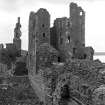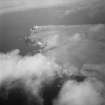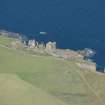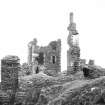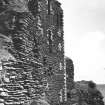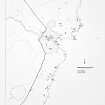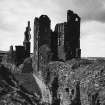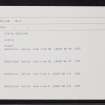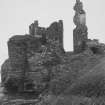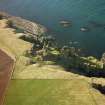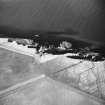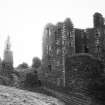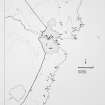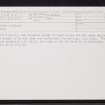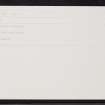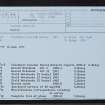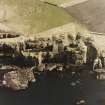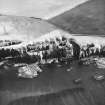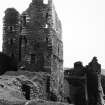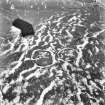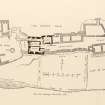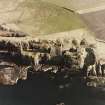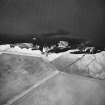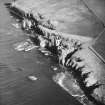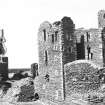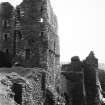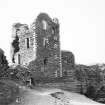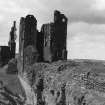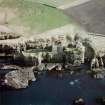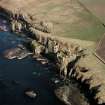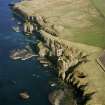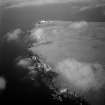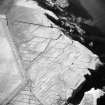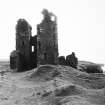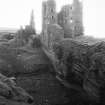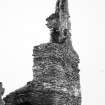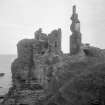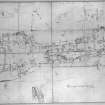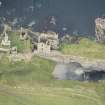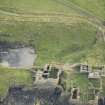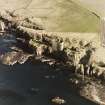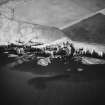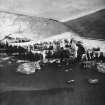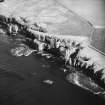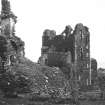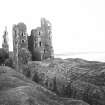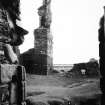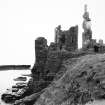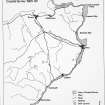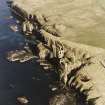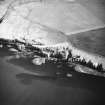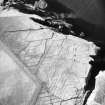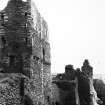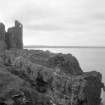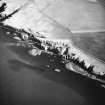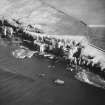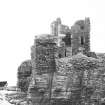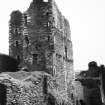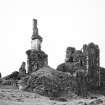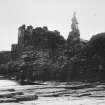Pricing Change
New pricing for orders of material from this site will come into place shortly. Charges for supply of digital images, digitisation on demand, prints and licensing will be altered.
Castle Sinclair
Castle (17th Century)
Site Name Castle Sinclair
Classification Castle (17th Century)
Alternative Name(s) Wic 142b; Sinclair Castle; Castle Haven; Girnigoe
Canmore ID 9180
Site Number ND35SE 48
NGR ND 3781 5491
Datum OSGB36 - NGR
Permalink http://canmore.org.uk/site/9180
- Council Highland
- Parish Wick
- Former Region Highland
- Former District Caithness
- Former County Caithness
ND35SE 48 3781 5491
See also ND35SE 15.
Castle Sinclair, successor to Castle Girnigoe (ND35SE 15) and erected in its outer ward in 1606. Reflecting the changing taste of its period, it was a building of some architectural pretension, three storeys high in part, with apartments forming a N range and offices along the S curtain. The castle belonged to the Sinclair Earls of Caithness, and it was a dispute about succession which led to the attack in 1679 which so damaged the castle that it was abandoned
D MacGibbon and T Ross 1887-92; RCAHMS 1911; N Tranter 1962-70.
Of Castle Sinclair, one fragment stands to roof height but the other walls have a maximum height of 5m and some are turfed-over foundations, 0.4m high. The outer walls are generally 1.5m thick, but some to the SW reach 3m in thickness.
Visited by OS, 21 April 1963.
Castle Sinclair
(remains of) [NAT]
OS (GIS) MasterMap, November 2010.
Plate XLVI - Carved stones from Castle Sinclair now at Ackergill Tower
Plate XLIX - Supporters of Arms from Castle Sinclair now at Ackergill Tower
(Undated) information in NMRS.
Excavation (March 2008 - November 2008)
ND 3779 5490 Four sessions of fieldwork were undertaken, from March–November 2008, continuing the excavation of the Outer Bailey. In the first session the NE tower of the N range was excavated. Rubble collapse was removed, the work being halted upon contact with the mid-17th-century deposits associated with Commonwealth troops’ use of the castle. The basement room was shown to have been furnished with a fireplace with storage cupboards on either side. A connecting staircase linking the tower with an adjacent lodging to the W was also revealed.
The east quadrant of the Outer Bailey and the basement level passageway were excavated during the second
session, revealing two areas of slate flagstone floors and the foundations of structures belonging to the earliest layout of the Outer Bailey.
During the third session rubble collapse from the bakehouse was excavated from the S range. This revealed a bee-hive shaped bread oven with collapsed roof and integral door opening and a slate flagstone floor beneath Commonwealth midden deposits. Excavation of the upper levels of the gatehouse lodgings was completed and an architectural stone bearing the cockerel emblem of the Sinclair family was recovered from the rubble. This may have been set in an internal wall in the gatehouse lodgings or represent a boss from a vaulted ceiling.
During the fourth session excavation of the stair turret revealed two intact flights of stairs beneath rubble collapse deposits including an under stair area. The original doorway into the ground floor gatehouse lodging was revealed with the southern jamb still furnished with its red sandstone quoins, with niches for door locks and bolts.
Archive: Post-excavation work is ongoing, and a report is to be deposited with RCAHMS
Funder: Clan Sinclair Trust
Field Archaeology Specialists Ltd, 2008
Excavation (April 2009 - August 2009)
ND 3779 5490 Three sessions of fieldwork were undertaken during 2009. The first, during April and May, saw the completion of the excavation in the buildings of the Outer Ward. The excavation of the ground floor West Gatehouse was completed, revealing a number of window openings and recesses. Excavation ceased at the mid-17th-century deposits associated with Commonwealth troops using the castle. The surface finds recovered from this deposit suggested the room had been divided into separate, intensively occupied living spaces.
The second session during June and July saw the reinstatement of the Outer Ward courtyard in preparation for
its public opening in 2010.
The final session in August saw the initiation of the Moat Project, which is designed to explore the archaeology of the dry moat on the S side of the castle. Excavation focused on two main areas, the S entrance and the area beneath the bakehouse. Excavation beneath the bakehouse allowed an investigation of the area of structural failure in the castle’s fabric, and a possible fault in the bedrock was found to be responsible. Excavation around the S entrance revealed late 16th-century formal landscaping features. Visible on early photographs, this series of terraces, walls and a formal path had been buried and partially robbed. The removal of rubble
collapse deposits from the area of the S entrance revealed the original height of the opening, remains of an earlier entrance and finds associated with the stripping of the castle in the late 17th century, including ornate architectural stone fragments, window glass and lead cames.
Archive: Post-excavation is ongoing, and a report will be deposited with the RCAHMS
Funder: Clan Sinclair Trust
Field Archaeology Specialists Ltd
Excavation (June 2010 - July 2010)
ND 3779 5490 The fieldwork undertaken in June–July
2010 saw continued excavation around the S entrance and
revealed the continuation of features encountered in 2009
(DES 2009, 116–117). The excavation of the area immediately
within the S entrance allowed the definition of middens
relating to the occupation of the castle by Commonwealth
troops. The middens partially overlay a slate floor and these
deposits were left in situ. Rubble collapse deposits overlay
this horizon. Fragments of stone, window glass and lead
cames were recovered from the collapse deposits.
Report: RCAHMS (intended)
Funder: Clan Sinclair Trust
Note (July 2017)
A Tale of Two Castles?
Despite the reference to two Castles at the site in much of the 19th and 20th literature, this is in fact one castle site, albeit one with a complex history [Canmore reflects this historic inaccuracy]. Attempts by the family to have it renamed Castle Sinclair in the early 17th century led to a tendency from at least 1701 to call the later elements of the castle Sinclair while the earlier elements retained the earlier name Girnigoe. The modern name of the site combines these elements, reflecting the coherence of the site as a single complex.
Approaching the castle from the land, the visitor first crosses a dry ditch that exploits a natural gully to create a formidable barrier. A large western gatehouse protected the principal entrance, giving way to an outer bailey with ranges along its SW, NW and SE sides. To the NE a second dry ditch impeded access to the remainder of the site, dominated by a tower house. Beyond this a narrow inner bailey was lined with structures on its NW and SE sides including, at the NE end, some of the earliest buildings on the site. Much of the site is conceived with defence in mind – the two ditches and their original drawbridges, a portcullis, gun loops and thick curtain walls making it effectively impregnable. That said, there are at least three subsidiary entrances that may have been used to victual the castle from the sea. As with other medieval castles the upper floors of the tower, gatehouse and bailey ranges provided accommodation for the Earl and his guests.
Castle History
The most recent analysis of the castle suggests that it has its origins in the 14th century, although it is perfectly possible that it re-uses an earlier site. In the late 14th or early 15th century the building currently known as the west gatehouse (often called Castle Sinclair) was erected. By the end of the 15th century the curtain wall had been built incorporating gun loops intended for the armament of the period, while a structure had been established on the site of the central tower house. In the late 16th and early 17th centuries the central tower house (known as Castle Girnigoe) was erected in its current form and the western gatehouse was embellished and enlarged – this work coincides with the renaming of the castle and with the date inscribed on a stone recorded in 1720. In the 1650s the castle was occupied by Cromwellian troops, and subsequently repaired, but it was badly damaged by an attack in 1680. By 1700 the building was effectively a ruin, and formed an important node in the development of a Romantic vision of Scotland’s past.
Despite the worst efforts of the unforgiving Caithness weather and stone robbing, the remains of this stronghold of the Earls of Caithness survive in a state where the visitor can still appreciate the architecture, power and status of the Earls of Caithness. Of all the castles in Scotland this unusually named castle demonstrates the skill of the architects and builders in adapting their construction to the constraints of the landscape whilst also making a statement about the power and status of its owners.
Recently the Clan Sinclair Trust have undertaken repairs and archaeological excavation as well as improving access. Despite this great care must at all times be taken when visiting this castle.
Sources:
Close-Brooks, J (1995) The Highlands, Exploring Scotland's Heritage series, ed. by Anna Ritchie. 2nd. Edinburgh. Page(s): 104-105
FAS (2003) Castle Sinclair Girnigoe Conservation Plan Volume 1 – Understanding the Site, Unpublished report for the Clan Sinclair Trust.
MacGibbon and Ross, D and T. (1887-92) The castellated and domestic architecture of Scotland from the twelfth to the eighteenth centuries, 5v. Edinburgh. Page(s): 306-318
Miller, D B. (1978) Historical castles and families of the north. 7. Girnigoe Castle- The first to sixth Earls of Caithness', Caithness Fld Club Bull, vol. 2, 3, 1978, April. Page(s): 83-9
RCAHMS (1911) Third report and inventory of monuments and constructions in the county of Caithness. Edinburgh, No. 497
Allan Kilpatrick - Data and Recording Projects Officer, and George Geddes - Archaeology Project Manager








































































